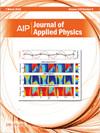减少界面缺陷可增强 Mo-SiNx 粒状金属的普遍幂律响应
IF 2.7
3区 物理与天体物理
Q2 PHYSICS, APPLIED
引用次数: 0
摘要
粒状金属(GMs)由绝缘基体隔开的金属纳米颗粒组成,经常作为电子传输基础研究的平台。然而,技术上成熟的颗粒金属器件却寥寥无几,这在很大程度上是因为其内在缺陷(如电子捕获点和金属/绝缘体界面缺陷)经常阻碍电子传输,尤其是在不含贵金属的颗粒金属中。在这里,我们证明了通过优化溅射沉积气氛可以最大限度地减少氮化钼硅(Mo-SiNx)GM 中的此类缺陷。对于在 Ar/N2 混合环境中沉积的 Mo-SiNx GM,X 射线光发射光谱显示,与在纯 Ar 环境中溅射的 Mo-SiNx GM 相比,界面 Mo-silicide 缺陷减少了 40%-60%。电子传输测量证实了缺陷密度的降低;直流电导率提高(降低)了 104-105,可变范围跳跃的活化能提高了 10 倍。由于 GM 是无序材料,理论上 GM 纳米结构应支持普遍幂律(UPL)响应;但实际上,这种响应通常会被电阻(缺陷)传输所淹没。在这里,缺陷最小化的 Mo-SiNx GM 显示出超线性 UPL 响应,我们将其量化为 1 MHz 时的电导率与直流电导率之比Δσω。值得注意的是,这些 GM 显示的 Δσω 高达 107,比之前报道的 GM 响应提高了三个数量级。通过使用非贵金属 GM 实现高性能电力传输,这项工作代表着向新的 UPL 基础研究和可扩展的成熟 GM 设备应用迈出了重要一步。本文章由计算机程序翻译,如有差异,请以英文原文为准。
Interfacial defect reduction enhances universal power law response in Mo–SiNx granular metals
Granular metals (GMs), consisting of metal nanoparticles separated by an insulating matrix, frequently serve as a platform for fundamental electron transport studies. However, few technologically mature devices incorporating GMs have been realized, in large part because intrinsic defects (e.g., electron trapping sites and metal/insulator interfacial defects) frequently impede electron transport, particularly in GMs that do not contain noble metals. Here, we demonstrate that such defects can be minimized in molybdenum–silicon nitride (Mo–SiNx) GMs via optimization of the sputter deposition atmosphere. For Mo–SiNx GMs deposited in a mixed Ar/N2 environment, x-ray photoemission spectroscopy shows a 40%–60% reduction of interfacial Mo-silicide defects compared to Mo–SiNx GMs sputtered in a pure Ar environment. Electron transport measurements confirm the reduced defect density; the dc conductivity improved (decreased) by 104–105 and the activation energy for variable-range hopping increased 10×. Since GMs are disordered materials, the GM nanostructure should, theoretically, support a universal power law (UPL) response; in practice, that response is generally overwhelmed by resistive (defective) transport. Here, the defect-minimized Mo–SiNx GMs display a superlinear UPL response, which we quantify as the ratio of the conductivity at 1 MHz to that at dc, Δσω. Remarkably, these GMs display a Δσω up to 107, a three-orders-of-magnitude improved response than previously reported for GMs. By enabling high-performance electric transport with a non-noble metal GM, this work represents an important step toward both new fundamental UPL research and scalable, mature GM device applications.
求助全文
通过发布文献求助,成功后即可免费获取论文全文。
去求助
来源期刊

Journal of Applied Physics
物理-物理:应用
CiteScore
5.40
自引率
9.40%
发文量
1534
审稿时长
2.3 months
期刊介绍:
The Journal of Applied Physics (JAP) is an influential international journal publishing significant new experimental and theoretical results of applied physics research.
Topics covered in JAP are diverse and reflect the most current applied physics research, including:
Dielectrics, ferroelectrics, and multiferroics-
Electrical discharges, plasmas, and plasma-surface interactions-
Emerging, interdisciplinary, and other fields of applied physics-
Magnetism, spintronics, and superconductivity-
Organic-Inorganic systems, including organic electronics-
Photonics, plasmonics, photovoltaics, lasers, optical materials, and phenomena-
Physics of devices and sensors-
Physics of materials, including electrical, thermal, mechanical and other properties-
Physics of matter under extreme conditions-
Physics of nanoscale and low-dimensional systems, including atomic and quantum phenomena-
Physics of semiconductors-
Soft matter, fluids, and biophysics-
Thin films, interfaces, and surfaces
 求助内容:
求助内容: 应助结果提醒方式:
应助结果提醒方式:


